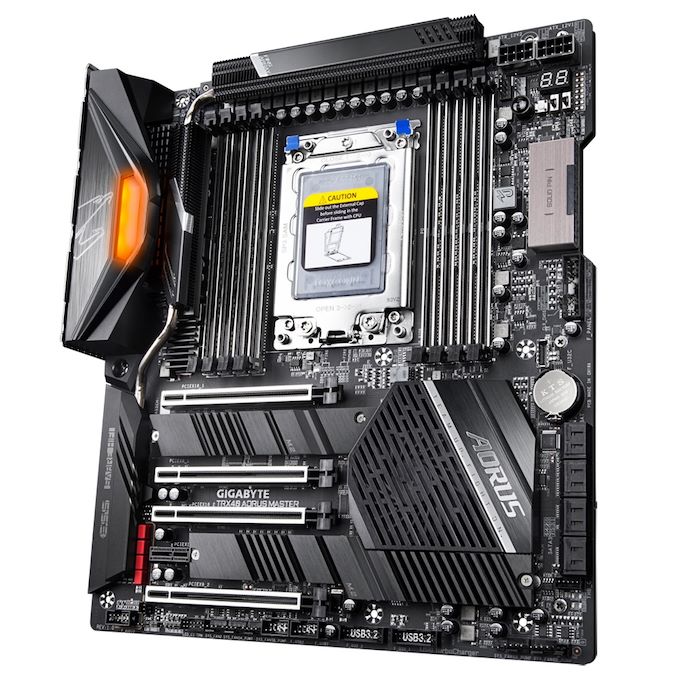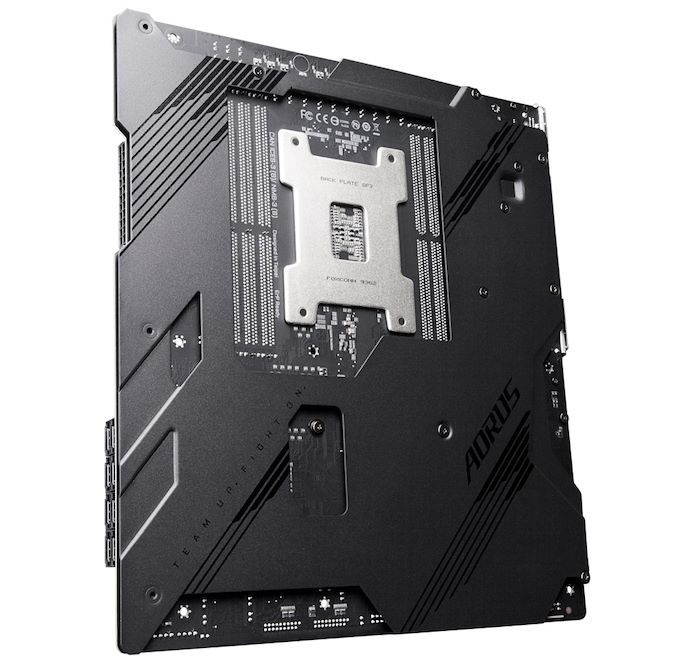The AMD TRX40 Motherboard Overview: 12 New Motherboards Analyzed
by Gavin Bonshor on November 28, 2019 9:00 AM EST- Posted in
- Motherboards
- AMD
- MSI
- Gigabyte
- ASRock
- Asus
- TRX40
- Threadripper 3000
- Castle Peak
GIGABYTE TRX40 Aorus Master
The GIGABYTE TRX40 Aorus Master sits below the TRX40 Aorus Xtreme in the product stack and combines a similar style, in a slightly smaller, but still larger than normal E-ATX PCB. Still retaining the high-end feel, the TRX40 Master is using an E-ATX PCB which is crammed with good quality controllers. The most notable features include support for DDR4-4400 and 256 GB, a pair of Ethernet ports on the rear panel including an Aquantia 5 G controller, Intel's AX200 Wi-Fi 6 wireless interface, and a beefy 16-phase CPU power delivery.
Starting from the top, the GIGABYTE TRX40 Aorus Master has eight memory slots in two banks of four on either side of the sTRX4 socket with support for DDR4-4400 and up to 256 GB in total. Taking a slightly more basic approach to the aesthetics, the rear panel cover does include integrated RGB LEDs, with black heatsinks on a black PCB. The large black aluminium power delivery heatsinks which are interconnected via a heat pipe are cooling a 16-phase power which consists of an Infineon XDPE132G5C 16-phase PWM controller, with sixteen Infineon TDA21472 70 A power stages. Providing power to the CPU is two 8-pin 12 V ATX power connectors which are located in the top right-hand corner.
Also at the top right-hand corner of the board is a two-digit LED debug, while below this is a right-angled 24-pin motherboard power connector. For PCIe devices, there are four full-length PCIe 4.0 slots which operate at x16/x8/x16+x8 and a single PCIe 4.0 x1 slot. The TRX40 chipset heatsink is actively cooled just as we saw with X570. For storage, the GIGABYTE TRX40 Aorus Master has three PCIe 4.0 x4 M.2 slots which include M.2 heatsinks for each slot, and there are eight SATA ports with support for RAID 0, 1, and 10 arrays.
Like with the GIGABYTE TRX40 Aorus Xtreme, the TRX40 Aorus Master also includes a large black metal backplate which will add extra weight to the board. The backplate displays the motto 'Team Up, Fight On' which is more of a gaming term, which is understandable given the boards Aorus branding. The TRX40 Aorus Master includes dual BIOS with a switch which allows users to select between the two, and for cooling, there is a total of eight 4-pin headers. These are split into one for a CPU fan, one dedicated for a water pump, and six for chassis fans.
On the rear panel are five USB 3.1 G2 Type-A, one USB 3.1 G2 Type-C, and two USB 2.0 ports. There are two Ethernet ports with one controlled by an Aquantia 5 G, and the other by an Intel Gigabit Ethernet controller. This model also includes Intel's AX200 Wi-Fi 6 wireless interface and also adds BT 5.0 connectivity too. To the left-hand side is a Clear CMOS and Q-Flash Plus switch, with the five 3.5 mm audio jacks and S/PDIF optical output handled by a Realtek ALC4050H and Realtek ALC1220 audio codec pairing. The TRX40 Aorus Master also includes a Realtek ALC4050H and ESS Sabre 9218 DAC for the front panel audio.
The GIGABYTE TRX40 Aorus Master is still a high-end TRX40 motherboard and with an MSRP of $499, it isn't exactly cheap, but it does offer users plenty of good quality features on AMD's new HEDT platform. While the Aorus brand is mainly targeted at gamers, the TRX40 Aorus Master looks to combine elements from both the enthusiast and gaming sides, to create a reasonably priced multi-purpose model for all looking to use and unlock all of the power within the Threadripper 3000 processors.













109 Comments
View All Comments
PopinFRESH007 - Sunday, December 29, 2019 - link
PCIe is a serial point to point topology so each link or "lane" is independent (ignoring things like PCIe switches). This is different to the legacy PCI bus which is a shared parallel bus which would behave as you've described.Dionysos1234 - Thursday, November 28, 2019 - link
Any information on what memory is supported? ECC?Llawehtdliub - Saturday, November 30, 2019 - link
Yes ECC is supportedVatharian - Thursday, November 28, 2019 - link
Has anyone from ASUS actually thought even for a second about the PCI-Express slots placement? Using dual GPUs, until converted truly to single slot with water cooling, blocks most of the slots. In my case I'd need 4 or 5 slots, which leaves ROG Zenith II Extreme from their linup. And ASRock Creator. As much as I hate Gigabyte I must admit their Aorus line has sensible layouts, and MSI's are mixed bag.nevcairiel - Thursday, November 28, 2019 - link
These boards are clearly not designed for Dual GPU purposes, but instead actually offer quite some space for the primary GPU (3 slots is mandatory for many high-end air cooled cards these days), and additional slots for other 1 slot cards.eek2121 - Friday, November 29, 2019 - link
Nearly every board I looked at in the article has spacing for multiple GPUs.eek2121 - Friday, November 29, 2019 - link
I noticed you said 3 slots. I have a high end GPU, it takes 2 slots. The 3rd slot is extremely far away from the 2nd slot and could comfortably fit a GPU. Factor in the width of an m.2 drive when looking at the pictures above and you'll realize you are mistaken (many of the boards have m.2 slots in between, That is all the space you need for air cooling a GPU, since most high end hardware only takes up 2 slots, the 3rd 'slot' is actually where an M.2 drive would sit, and the real third slot is below it, leaving plenty of space for cooling fan air circulation).Spunjji - Friday, November 29, 2019 - link
Serious question - are dual-GPUs even used these days?I know they're out for gaming, but I don't know the state of play regarding GPU compute.
Bccc1 - Friday, November 29, 2019 - link
For GPU rendering (e.g. Redshift, Octane and VRay Next) dual GPUs are quite common and even quad GPUs can be used quite efficiently.eek2121 - Friday, November 29, 2019 - link
I don't kow about the "blocking most of the slots" terminology. On my X399 board, only 1 slot is blocked (and technically you still could put a card in that slot, I actually had a low profile x4 card next to my GPU without any heat issues). On many X570 boards, spacing is such that no slots are blocked. In both cases, there are single slot GPUs, just not high end ones. As you've stated, using a custom loop allows for even high end GPUs to use only 1 slot.